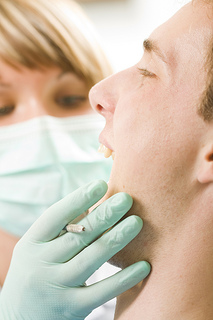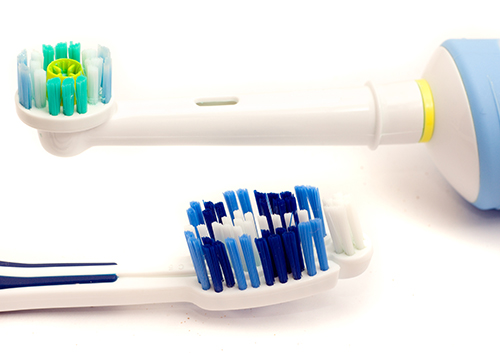August 4th, 2017

Oral cancer is largely viewed as a disease that affects those over the age of 40, but it can affect all ages, even non-tobacco and alcohol users. Oral cancer can occur on the lips, gums, tongue, inside lining of the cheeks, roof of the mouth, and the floor of the mouth. Our team at Isles Dental recently put together some facts and figures to illustrate the importance of visiting our Minneapolis, MN office.
Our friends at the American Cancer Society recommend an oral cancer screening exam every three years for people over the age of 20 and annually for those over age 40. Because early detection can improve the chance of successful treatment, be sure to ask Dr. Sepi Taghizadeh and our team to conduct an oral exam during your next visit to our Minneapolis, MN office.
- Symptoms of oral cancer may include a sore in the throat or mouth that bleeds easily and does not heal, a red or white patch that persists, a lump or thickening, ear pain, a neck mass, or coughing up blood. Difficulties in chewing, swallowing, or moving the tongue or jaws are often late symptoms.
- The primary risk factors for oral cancer in American men and women are tobacco (including smokeless tobacco) and alcohol use. Risk rises dramatically (30%) for people who both smoke and consume alcohol regularly.
- Oral cancers are part of a group of cancers commonly referred to as head and neck cancers, and of all head and neck cancers they comprise about 85% of that category.
- Oral cancer is the sixth most common cancer among men.
- Oral cancer is more likely to affect people over 40 years of age, though an increasing number of young people are developing the condition.
- Death rates have been decreasing over the past three decades; from 2004 to 2008, rates decreased by 1.2% per year in men and by 2.2% per year in women, according to the American Cancer Society.
- About 75% to 80% of people with oral cavity and pharynx cancer consume alcohol.
- The risk of developing oral cavity and pharynx cancers increases both with the amount as well as the length of time tobacco and alcohol products are used.
- For all stages combined, about 84% of people with oral cancer survive one year after diagnosis. The five- and ten-year relative survival rates are 61% and 50%, respectively.
- It is estimated that approximately $3.2 billion is spent in the United States annually on treatment of head and neck cancers.
Cancer can affect any part of the oral cavity, including the lip, tongue, mouth, and throat. Through visual inspection, Dr. Sepi Taghizadeh and our team at Isles Dental can often detect premalignant abnormalities and cancer at an early stage, when treatment is both less extensive and more successful.
Please let us now if you have any questions about your oral health either during your next scheduled appointment, by giving us a call or asking us on Facebook.
July 28th, 2017

If you're scheduled to get a dental implant, it's only natural to have questions about it. The pain involved is usually on the mind of most patients. Of course, some discomfort is possible, as with any major dental procedure. Having a well-defined plan ahead of time, which is carried out by Dr. Sepi Taghizadeh, reduces the risk of complications or side effects post-surgery.
During the procedure you won't feel a thing, since it is performed under general or local anesthesia that totally numbs your mouth. It's more likely that you will feel some pain or discomfort after the anesthesia has worn off.
There are usually three things that will affect the length and intensity of any discomfort:
- The complexity of your surgery (for example if you need a bone graft or sinus lift beforehand)
- How well-trained the dental team which works on your case is (it may be multiple people, including a periodontist, oral surgeon, and/or general dentist)
- How quickly your body is able to heal itself post-surgery
The pain experienced from an untreated case will usually far outweigh that experienced from a dental implant. Good oral hygiene after your surgery is important to avoid infection. Salt water rinses are generally recommended 24 hours after your surgery. Brush your teeth gently around the implant.
It's also a good idea not to eat any food that is too hot, cold, or hard. Soft or pureed foods will help you to avoid chewing for the first few days after surgery and will help your mouth to heal faster. You'll typically be prescribed pain medication, but some patients find that ibuprofen or acetaminophen work well enough. Just remember, the most severe discomfort is usually experienced within the six hours after your anesthesia wears off.
Getting a dental implant is a big decision, and we want to make sure you get through it easily. Our Minneapolis, MN team is here to help if you have any questions about the procedure or post-surgery care.
July 21st, 2017

You live in the golden age of toothbrushes. Until a few decades people used twigs or brushes made from animal hair to clean their teeth: not very soft and none too effective.
Now, you have a choice of manual brushes with soft, medium, or hard bristles. Or you might choose to go with an electric toothbrush instead.
Have you ever wondered whether manual or electric brushes provide better cleaning? Actually, they both do the job. The key is to brush and floss every day, regardless of the kind of brush you prefer.
At our Minneapolis, MN office, we like to say the best brush is the one you'll use. So if you prefer manual, go for it. If you prefer electric, turn it on.
Both types have their advantages but both types will get the job done as far as removing plaque.
Electric Toothbrushes
- Provide power rotation that helps loosen plaque
- Are great for people with limited dexterity due to arthritis or other problems
- Are popular with kids who think the electric brushes are more fun to use
- Can come with variable speeds to help reduce pressure on sensitive teeth and gums
Manual Toothbrushes
- Can help brushers feel they have more control over the brushing process
- Allow brushers to respond to twinges and reduce the pressure applied to sensitive teeth and gums
- Are more convenient for packing when traveling
- Manual brushes are cheaper and easier to replace than the electric versions.
In many ways, the golden age is just beginning. There are already phone apps available to remind you to brush and floss. New apps can play two minutes worth of music while you brush, help you compare the brightness of your smile or help explain dental procedures. Maybe someday we’ll even have programs that examine your teeth after brushing and identify spots you might have missed.
July 14th, 2017

Never before have dental implants looked as natural and aesthetically pleasing as they do today. With the help of computer-aided design and computer aided manufacturing (CAD/CAM), Dr. Sepi Taghizadeh and our team are able to create implants with impeccable fit and finish. Although these technologies have been in use since the 1980s, it's only recently that they became efficient and cost-effective enough to be useful.
Dr. Sepi Taghizadeh can also take digital scans of your teeth, providing a much more in-depth and accurate representation of them when compared to traditional X-rays. This scan can be used to create a physical model of your teeth through the use of 3D printing technology, allowing for the utmost in accuracy when planning your implant treatment.
Since each of our patients are unique, these CAD/CAM technologies offer a highly customized approach to implant dentistry that helps avoid the "one-size-fits-all" ways of the past. The goal is to have an implant look and function as closely as it can to the tooth it's replacing. That’s why these implants are typically milled using ceramic or composite resin — materials chosen due to their durability and resemblance to teeth.
Even the planning of your surgery can be aided and guided by computers. 3D CT scans create a digital representation of your mouth including all significant anatomical markers. This data is imported into planning software which, coupled with CAD/CAM implant technology, is able to 3D print surgical guides that snap into place over a patient's teeth. This means less risk for surgical error and much more accurately placed dental implants.
The main benefits of CAD/CAM dental implants are that they:
- Are extremely accurate for every patient, down to 50 micrometers
- Have better long-term results and more natural-looking implants
- Can be manufactured quickly, the same day in many cases
Of course this is just a quick summary of the benefits, and a computer-modeled implant may not always be the best option. If you have questions about the dental implants or the technologies we use to make them look as natural as possible, feel free to contact our Minneapolis, MN office.







 Website Powered by Sesame 24-7™
Website Powered by Sesame 24-7™